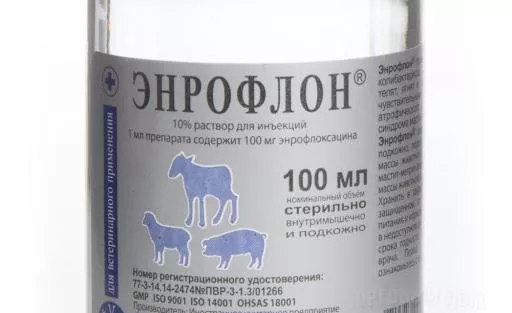Enroflon: instructions for use for chickens, contraindications and analogues
Many poultry diseases are caused by disorders of the digestive tract, excretory organs and reduced immunity. By following the instructions for the use of Enroflon for chickens, many diseases can be prevented and cured. Because it is a broad-spectrum drug. To use it effectively, it is recommended to prepare a fresh solution every day.
Form of release, composition and packaging of the drug
The drug is sold in glass or plastic bottles of various volumes (5-1000 ml). Enroflon is a 5 or 10% solution intended for oral use.Enrofloxacin is the active ingredient. And the auxiliary ones are benzyl alcohol, potassium hydrochloride, purified water.
The following information is indicated on each vial: manufacturer's name, name of the medicinal product and its content in the vial, date of manufacture and batch number, expiration date.
Pharmacological properties and effects of Enroflon
The antimicrobial drug belongs to the group of fluoroquinolones, has a wide spectrum of bactericidal action, suppresses microorganisms. The maximum concentration of Enroflon is observed after 1.5-2 hours after application, it lasts 5.5-6 hours. The drug belongs to the group of low-hazard substances.
Indications for use
The drug is prescribed for medicinal purposes in diseases caused by microorganisms sensitive to the action of fluoroquinolones. Also in cases of diagnosing enteritis, atrophic rhinitis, colibacillosis, salmonellosis, mycoplasmosis, bronchopneumonia in poultry.The therapeutic and prophylactic value of Enroflon is to improve digestion in birds, increase immunity and prevent the occurrence of dangerous infections.

Instructions for use and dosage
In the poultry industry, Enroflon solution is used to treat and prevent diseases, both in chickens and adults.
For chickens
Chickens of the first month of life do not have strong immunity, there are still problems with thermoregulation. The body reacts sharply to drafts, hypothermia or overheating. For prophylactic administration, the solution of the drug is diluted with drinking water (0.5 ml of the substance is taken per liter of water). When treating, the dosage is prescribed by the veterinarian. Usually, prevention and treatment courses last the same period - 3-5 days.
Important! In preventive measures, Enroflon is given to chicks from the first days of life. The most sensitive periods of life are considered from 1-5 days, 20-25 and 35-40.
For broilers
The solution is of particular preventive importance when growing broilers, since during the breeding experiments the bird has practically lost its immunity and has become very susceptible to bacterial infections.

Success of treatment depends on the speed of application of the drug after the onset of the first symptoms of the disease:
- sluggish, inhibited bird behavior;
- lacrimation and festering of the eyes;
- mucous discharge from the nasopharynx;
- hoarse breath sounds.
For treatment, a 10% solution of Enroflon is used, which is diluted in drinking water (at the rate of 1 ml per liter of water). A double dose is used to treat salmonellosis. As a rule, one course (3-5 days) of taking the drug is enough to restore the he alth of the bird.
For laying hens
As a rule, the immunity of an adult bird is stronger than that of chickens. However, poor housing conditions (crowding, poor nutrition, poor ventilation or drafts) provoke the appearance and spread of infections.

For the treatment of laying hens, Enroflon is prescribed in the same way as for broilers. At the same time, it is important to take into account that eggs of laying hens who are sick or under treatment should not be eaten, since the therapeutic drug is excreted not only with urine and bile, but also with eggs.
Consequences of overdose
Enroflon solution belongs to group B medicinal substances, the storage and administration of which is not carried out without medical supervision. Exceeding the dosage is fraught with an upset digestive system, slow weight gain.
Possible side effects
If you follow the instructions for the use of Enroflon, then the bird does not have manifestations of complications or side effects.Allergic reactions can occur due to individual intolerance to fluoroquinolones by the bird's body. In this case, the administration of the Enroflon oral solution is stopped and antihistamines are prescribed.

Contraindications for use
It is forbidden to use the drug for the treatment of birds with severe damage to the kidneys and liver. Individual intolerance to fluoroquinolones in animals is also a contraindication.
Special Instructions
During the treatment period, the bird is not allowed to be outdoors in direct sunlight (the effectiveness of the drug decreases). There is no particular effect of Enroflon at the first application or cancellation. It is not allowed to use for slaughter the bird, for the treatment of which the drug was used, earlier than 11 days after the cessation of the drug administration.
Terms and rules of storage
Dry places protected from sunlight are the recommended option for storing Enroflon solution. Suitable storage temperature is 5-25°C. In the original packaging, solutions of 5 and 10% can be stored for 3 years from the date of manufacture.
Analogues of Enroflon
Common drugs, the main active ingredient of which is enrofloxacin, include: Enrocept (also contains cyclopropyl), Baytril, Enroxil. Enroflon is an effective anti-infective drug that also has an antibacterial effect. Low toxicity is an important advantage of the drug. But when using it, it is important to observe the dosage and take into account the compatibility of Enroflon with other medicines.
Recommended
Oflosan for chickens: instructions for use and composition, dosage and analogues

Composition and purpose of "Oflosan" for chickens. Instructions for use means for chickens. Side effects and contraindications. Compatibility with other drugs and analogues.
Enroflon for ducklings: instructions for use and composition, dosage and analogues

Rules for taking "Enroflon" for ducklings, according to the instructions for use. Release form and composition of the drug. Indications and contraindications, possible side effects and analogues.
Chiktonik for chickens: instructions for use, composition and contraindications

Chiktonik, use for chickens of different ages. Description, pharmacological action. Instructions for use. Side effects and contraindications. Storage rules.

